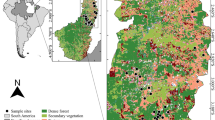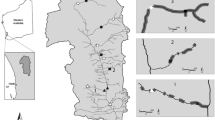Abstract
There is a frequent energy flow connection between streams and riparian zones. However, riparian communities have been limited in studies of stream ecosystems. To understand the significance of riparian communities in the energy flow of stream ecosystems, we compared two trophic models in a small forest tributary (the Feifong Stream) and the mainstream (the Houlong Stream) that possessed high and low biomasses of riparian vegetation and arthropods, respectively. There were 25 functional groups classified into 3 integer trophic levels in the two trophic models. Arthropods, mostly insects, were the main carrier of the energy flow between aquatic and riparian habitats. The feeding connections were more extensive and intensive in the tributary than in the mainstream, as riparian arthropods were more abundant in the tributary. When including the riparian community in the tributary, the trophic model became more mature, as the values of system omnivory index and trophic transfer efficiency and the ascendency: capacity ratio were higher, but the connectance index value and overhead: capacity ratio were lower in the model with riparian groups than in the model without riparian groups. In the tributary, the ecotrophic efficiency (EE) values of aquatic insect groups increased largely if the riparian community was included in the model. In the mainstream, however, most of the ecosystem attributes and the EE values of aquatic insect groups did not obviously change if the model included the riparian community. This study highlights the significance of riparian communities in the energy flow of subtropical stream ecosystems. Aquatic and riparian systems should be considered together as a mature ecosystem for the planning of stream conservation. The loss or degradation of one habitat may have more detrimental effects on the other community than we have previously recognized, particularly in a small forest stream.





Similar content being viewed by others
Data availability statement
The data that support the findings of this study are available from the corresponding author upon reasonable request.
Code availability
Not applicable.
References
Angermeier PL (1985) Spatio-temporal patterns of foraging success for fishes in an Illinois stream. Am Midl Nat 114(2):342–359. https://doi.org/10.2307/2425609
Atlas WI, Palen WJ, Courcelles DM, Munshaw RG, Monteith ZL (2013) Dependence of stream predators on terrestrial prey fluxes: food web responses to subsidized predation. Ecosphere 4(6):1–16. https://doi.org/10.1890/es12-00366.1
Ballinger A, Lake PS (2006) Energy and nutrient fluxes from rivers and streams into terrestrial food webs. Mar and Freshw Res 57(1):15–28. https://doi.org/10.1071/MF05154
Bartels P, Cucherousset J, Steger K, Eklöv P, Tranvik LJ, Hillebrand H (2012) Reciprocal subsidies between freshwater and terrestrial ecosystems structure consumer resource dynamics. Ecology 93(5):1173–1182. https://doi.org/10.1890/11-1210.1
Baxter CV, Fausch KD, Carl SW (2005) Tangled webs: reciprocal flows of invertebrate prey link streams and riparian zones. Freshw Biol 50(2):201–220. https://doi.org/10.1111/j.1365-2427.2004.01328.x
Christensen V, Pauly D (1998) Changes in models of aquatic ecosystems approaching carrying capacity. Ecol Appl 8(1):S104–S109
Christensen V, Walters C, Pauly D (2005) Ecopath with Ecosim: a user's guide. In: Fisheries Centre, University of British Columbia, Vancouver
Chuang SA, Lee LL (1997) Food habits of three carnivore species (Viverricula indica, Herpestes urva, and Melogale moschata) in Fushan forest, northern Taiwan. J Zool 243(1):71–79. https://doi.org/10.1111/j.1469-7998.1997.tb05757.x
Clesceri LS, Greenberg AE, Eaton AD (1998) Standard methods for the examination of water and wastewater, 20th edn. American Public Health Association, Washington, DC
Cloe W III, Garman G (1996) The energetic importance of terrestrial arthropod inputs to three warm-water streams. Freshw Biol 36(1):104–114. https://doi.org/10.1046/j.1365-2427.1996.00080.x
Ellwood MDF, Foster WA (2004) Doubling the estimate of invertebrate biomass in a rainforest canopy. Nature 429(6991):549–551
Erwin TL (1983) Beetles and other insects of tropical forest canopies at Manaus, Brazil, sampled by insecticidal fogging. In: Sutton SL, Whitmore TC, Chadwick AC (eds) Tropical rain forest: ecology management. Blackwell Scientific Publications, Oxford, pp 59–75
Field JG, Wulff F, Mann KH (1989) The need to analyze ecological networks. In: Wulff F, Field JG, Mann KH (eds) Network analysis in marine ecology: methods and applications. Springer, Heidelberg, pp 3–12
Fisher SG, Likens GE (1973) Energy flow in Bear brook, new hampshire: an integrative approach to stream ecosystem metabolism. Ecol Monogr 43(4):421–439. https://doi.org/10.2307/1942301
Funtowicz SO, Ravetz JR (1990) Uncertainty and quality in science for policy. Springer, Dordrecht. https://doi.org/10.1007/978-94-009-0621-1
Garman GC (1991) Use of terrestrial arthropod prey by a stream-dwelling cyprinid fish. Environ Biol Fishes 30(3):325–331
Gebre SL, Ludwig F (2015) Hydrological response to climate change of the upper Blue Nile River Basin: based on IPCC fifth assessment report (AR5). J Climatol Weather Forecast 3(1):1–15. https://doi.org/10.4172/2332-2594.1000121
Gilvear DJ, Spray CJ, Casas-Mulet R (2013) River rehabilitation for the delivery of multiple ecosystem services at the river network scale. J Environ Manage 126:30–43. https://doi.org/10.1016/j.jenvman.2013.03.026
Gratton C, Zanden MJV (2009) Flux of aquatic insect productivity to land: comparison of lentic and lotic ecosystems. Ecology 90(10):2689–2699. https://doi.org/10.1890/08-1546.1
Hoekman D, Dreyer J, Jackson RD, Townsend PA, Gratton C (2011) Lake to land subsidies: Experimental addition of aquatic insects increases terrestrial arthropod densities. Ecology 92(11):2063–2072. https://doi.org/10.1890/11-0160.1
Jeffrey S, Humphrey G (1975) New spectrophotometric equations for determing chlorophylls a, b, cl and c2 in higher plants, algae and natural phytoplankton. Biochem Physiol Pflanzen 167:191–194
Kawaguchi Y, Taniguchi Y, Nakano S (2003) Terretrial invertebrate inputs determine the local abundance of stream fishes in a forested stream. Ecology 84(3):701–708. https://doi.org/10.1890/0012-9658(2003)084[0701:tiidtl]2.0.co;2
Kay JJ, Graham LA, Ulanowicz RE (1989) A detailed guide to network analysis. In: Wulff F, Field JG, Mann KH (eds) Network analysis in marine ecology: methods and applications. Springer, Heidelberg, pp 15–61
Knight TM, McCoy MW, Chase JM, McCoy KA, Holt RD (2005) Trophic cascades across ecosystems. Nature 437(7060):880–883
Lee LH, Hsieh LY, Lin HJ (2011) Spatio-temporal variability of benthic metabolism during emersion and annual budget on subtropical intertidal sandflats. Mar Ecol Prog Ser 441:3347
Lemmon PE (1956) A spherical densiometer for estimating forest overstory density. For Sci 2(4):314–320. https://doi.org/10.1093/forestscience/2.4.314
Libralato S, Christensen V, Pauly D (2006) A method for identifying keystone species in food web models. Ecol Model 195(3):153–171. https://doi.org/10.1016/j.ecolmodel.2005.11.029
Lin HJ, Wang YC, Wu SH et al (2008) Longterm ecological monitoring and ecosystem modeling in the wuling area. In: Shei-Pa National Park Administration, Miaoli
Lin HJ, Peng TR, Cheng IC, Chen LW, Kuo MH, Tzeng CS, Tsai ST, Yang JT, Wu SH, Sun YH, Yu SF, Kao SJ (2012) Trophic model of the subtropical headwater stream habitat of Formosan landlocked salmon Oncorhynchus formosanus. Aquat Biol 17:269–283. https://doi.org/10.3354/ab00481
Lynam CP, Llope M, Möllmann C, Helaouët P, Bayliss-Brown GA, Stenseth NC (2017) Interaction between top-down and bottom-up control in marine food webs. PNAS 114(8):1952–1957. https://doi.org/10.1073/pnas.1621037114
Nakano S, Murakami M (2001) Reciprocal subsidies: dynamic interdependence between terrestrial and aquatic food webs. PNAS 98(1):166–170. https://doi.org/10.1073/pnas.98.1.166
Nakano S, Miyasaka H, Kuhara N (1999) Terrestrial-aquatic linkage: riparian arthropod inputs alter trophic cascades in a stream food web. Ecology 80(7):2435–2441. https://doi.org/10.1890/0012-9658(1999)080[2435:talrai]2.0.co;2
Odum HT (1956) Primary production in flowing waters. Limnol Oceanogr 1(2):102–117. https://doi.org/10.4319/lo.1956.1.2.0102
Odum EP (1969) The strategy of ecosystem development. Science 10:262–270
Odum EP (2014) The strategy of ecosystem development. In: Ndubisi FO (ed) The ecological design and planning reader. Springer, Heidelberg
Paetzold A, Schubert CJ, Tockner KJ (2005) Aquatic terrestrial linkages along a braided-river: riparian arthropods feeding on aquatic insects. Ecosystems 8(7):748–759
Power ME, Tilman D, Estes JA, Menge BA, Bond WJ, Mills LS, Daily G, Castilla JC, Lubchenco J, Paine RT (1996) Challenges in the quest for keystones: identifying keystone species is difficult–but essential to understanding how loss of species will affect exosystems. Bioscience 46(8):609–620. https://doi.org/10.2307/1312990
Sabo JL, Power ME (2002) River–watershed exchange: effects of riverine subsidies on riparian lizards and their terrestrial prey. Ecology 83(7):1860–1869. https://doi.org/10.1890/0012-9658(2002)083[1860:RWEEOR]2.0.CO;2
Smith SV, Swaney DP, Talaue-Mcmanus L et al (2003) Humans, hydrology, and the distribution of inorganic nutrient loading to the ocean. Bioscience 53(3):235–245. https://doi.org/10.1641/0006-3568(2003)053[0235:HHATDO]2.0.CO;2
Snyder BA, Hendrix PF (2008) Current and potential roles of soil macroinvertebrates (earthworms, millipedes, and isopods) in ecological restoration. Restor Ecol 16(4):629–636. https://doi.org/10.1111/j.1526-100X.2008.00484.x
Soininen J, Bartels P, Heino J, Luoto M, Hillebrand H (2015) Toward more integrated ecosystem research in aquatic and terrestrial environments. Bioscience 65(2):174–182. https://doi.org/10.1093/biosci/biu216
Sweeney BW, Bott TL, Jackson JK, Kaplan LA, Newbold JD, Standley LJ, Hession WC, Horwitz RJ (2004) Riparian deforestation, stream narrowing, and loss of stream ecosystem services. PNAS 101(39):14132–14137. https://doi.org/10.1073/pnas.0405895101
Tsivoglou EC, Neal LA (1976) Tracer measurement of reaeration: III. Predicting the reaeration capacity of inland streams. J Water Pollut Control Fed 48(12):2669–2689
Tzeng CS, Lin HJ, Yang MM (2015) The plan of water environmental observation and investigation in Houlung River-The investigation and assessment of rivulet ecology conservatino (2/2). In: Water Resources Planning Institute, Taichung
Ulanowicz RE (2001) Information theory in ecology. Comput Chem 25(4):393–399. https://doi.org/10.1016/S0097-8485(01)00073-0
Ulanowicz RE, Puccia CJ (1990) Mixed Trophic Impacts in Ecosystems. Coenoses 5(1):7–16
Whitney EJ, Bellmore JR, Benjamin JR, Jordan CE, Dunham JB, Newsom M, Nahorniak M (2020) Beyond sticks and stones: integrating physical and ecological conditions into watershed restoration assessments using a food web modeling approach. Food Webs 25:e00160. https://doi.org/10.1016/j.fooweb.2020.e00160
Wu SH, Lin HJ, Yang MM (2015). The plan of water environmental observation and investigation in Houlung River-The investigation and assessment of forest ecology conservatino (1/2). In: Water Resources Planning Institute, Taichung
Zander KK, Straton A (2010) An economic assessment of the value of tropical river ecosystem services: heterogeneous preferences among Aboriginal and non-aboriginal australians. Ecol Econ 69(12):2417–2426. https://doi.org/10.1016/j.ecolecon.2010.07.010
Zhang Y, Richardson JS (2011) Contrasting effects of cross-ecosystem subsidies and predation on benthic invertebrates in two Pacific coastal streams. Aquat Sci 73(1):53–62. https://doi.org/10.1007/s00027-010-0159-2
Acknowledgements
We are grateful to the following colleagues in National Chung Hsing University: Ming-Yu Hung, Bao-Cheng Lai, Sheng-Feng Lin, Fu-Sheng Huang and Jhen-Ruei Lin for the help in field work; You-Ting Hsieh for his help in GIS software.
Funding
This study was financially supported by Water Resources Planning Institute, Water Resources Agency, the Ministry of Economic Affairs (Project code: 103-R-12-03-1-013-05-2) and in part by the “Innovation and Development Center of Sustainable Agriculture” from the Featured Areas Research Center Program within the Higher Education Sprout Project by the Ministry of Education (MOE) of Taiwan.
Author information
Authors and Affiliations
Contributions
Y-CL, A-CL, H-NT, Y-TY: investigation, formal analysis, visualization, data curation, writing. C-ST, M-MY: methodology, validation, supervision. H-JL: conceptualization, funding acquisition, supervision, resources, writing.
Corresponding authors
Ethics declarations
Conflict of interest
None of the authors declare any conflict of interest.
Ethics approval
The study did not involve endangered or protected species.
Consent to participate
Not applicable.
Consent for publication
Not applicable.
Additional information
Publisher's Note
Springer Nature remains neutral with regard to jurisdictional claims in published maps and institutional affiliations.
Supplementary Information
Below is the link to the electronic supplementary material.
Rights and permissions
About this article
Cite this article
Liao, YC., Lin, AC., Tsai, HN. et al. The significance of riparian communities in the energy flow of subtropical stream ecosystems. Aquat Sci 84, 20 (2022). https://doi.org/10.1007/s00027-022-00850-x
Received:
Accepted:
Published:
DOI: https://doi.org/10.1007/s00027-022-00850-x




